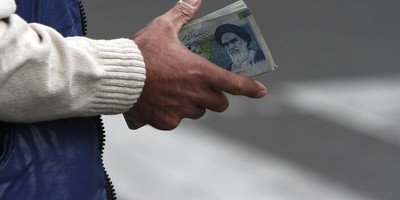Coinciding with the Easter celebration of Jesus Christ’s resurrection — the foundational basis of Christianity — is the annual controversy over whether there exists physical proof of this miraculous event.
The “evidence” is a 14.5' by 3.5' linen cloth known as the Shroud of Turin, believed by millions of Christians to be the authentic burial shroud of Jesus Christ. The cloth is preserved in an underground vault in the Cathedral of Saint John the Baptist in Turin, Italy, where it has resided since 1578.
Visible on the cloth in a faint yellowed color is a full front and back body image of a tortured adult male bearing the wounds of crucifixion. Additionally, every mark on the body image is consistent with the biblical accounts of Christ’s suffering. For example, there are over 100 scourge marks, while bloodstain patterns on his scalp and forehead suggest the painful “crown of thorns.” A large blood stain on his side is compatible with a spear wound. His knees are bruised, but his legs are not broken.
Does the “Man of the Shroud” reflect how Jesus looked the second before his resurrection? Answering that question is precisely why the Shroud’s mysterious yet scientifically proven properties have baffled generations of scientists and researchers. Also the reason why the Shroud continues to be the most analyzed artifact in the world.
Let’s explore the Shroud’s top five mysteries:
Mystery #1: The Shroud photographs as a photo-negative image.
In 1898 an Italian photographer named Secondo Pia obtained permission to apply the “new” technology of photography to the Shroud. When developing his photos, Pia was astonished to discover the Shroud’s first “modern” unexplained mystery – the Shroud photographs as a photo-negative image. That means the Shroud is a negative image that shows up positive when seen in a photographic negative.
Recommended

Photo-negative image of Shroud of Turin front and back side by side. Credit: © 1978 Barrie M. Schwortz Collection, STERA. Inc. All Rights Reserved. Permission granted to author.
Mystery #2: “The Shroud is not the product of an artist.”
Fast forward to 1978 when 40 distinguished scientists, famously known as STURP -- Shroud of Turin Research Project, obtained permission to perform what was then state of the art optical and chemical tests on the Shroud. The key objective of STURP was to determine the nature of the cloth’s image and bloodstains.
In 1981 STURP issued their comprehensive report. The last paragraph of the summary stated: “We can conclude for now that the Shroud image is that of a real human form of a scourged, crucified man. It is not the product of an artist. The blood stains are composed of hemoglobin and also give a positive test for serum albumin. The image is an ongoing mystery and until further chemical studies are made, perhaps by this group of scientists, or perhaps by some scientists in the future, the problem remains unsolved.”

The Shroud of Turin (vertical position) how it looks to the naked eye. Marks running the length of the Shroud on both sides of the image are from a fire in 1532 that almost destroyed the Shroud. Credit: Giorgio Bracaglia / Holy Shroud Guild PPF. Permission granted to author.
Mystery #3: How was the image formed?
STURP’s mission to solve the mystery of the substance used to form the image only deepened when their summary concluded:
“No pigments, paints, dyes or stains have been found on the fibrils. X-ray, fluorescence, and microchemistry on the fibrils preclude the possibility of paint being used as a method for creating the image. Ultra Violet and infrared evaluation confirm these studies.”
Mystery #4: The Shroud is encoded with 3D distance information.
Again, from STURP’s final report summary:
“Computer image enhancement and analysis by a device known as a VP-8 image analyzer show that the image has unique, three-dimensional information encoded in it.”
This 3D encoded information first visualized by STURP on a primitive image analyzer in 1978, was updated in 2010 and served as the basis for the History Channel’s documentary, “The Real Face of Jesus?” Seen by millions, the popular documentary aired annually on Easter weekend between the years 2010 – 2017.
I asked Ray Downing, the 3D artist who starred in the documentary and produced a life-portrait of Jesus based on the Shroud’s 3D information, to further explain this phenomenon. Downing said:
“What the Shroud mysteriously seems to retain is information about the distance the cloth was from parts of the body it presumably rested on, as well as parts of the body it was not in direct contact with.”
Mystery #5: Shroud image is uniform in intensity across both frontal and dorsal images.
Here to explain this unexplainable uniform intensity is Russ Breault, a world renowned Shroud expert who also starred in “The Real Face of Jesus?” Breault says:
“The image appears because something caused the accelerated dehydration and oxidation of the cellulose fibers comprising the linen—NOT because of any substance applied to the cloth. The image is only two micro-fibers deep—about 1% of a single thread and is uniform in intensity throughout the cloth--with no deviation -- a feat impossible with human hands!”
There are many more Shroud mysteries, but the previous five are the most baffling to scientists. Now the stage is set for what I call “Controversy #1” — the 1988 carbon-14 dating.
In 1988 the Shroud underwent a process known as carbon-14 dating. The test dated the Shroud between the years 1260 –1390. Immediately headlines around the globe screamed that the Shroud was a “medieval forgery” Today that moniker is still prevalent among Shroud naysayers, but those dates do not address or negate the five mysteries.
Subsequently, during last 30 years, the carbon -14 dating has been continually questioned and criticized. Again, here is Russ Breault to elaborate on this lingering controversy:
“The carbon dating controversy centers around tiny samples of the Shroud cut from an outer corner of the cloth. The area cut is from the most held and handled section thought to have been added during the Middle Ages as a repair or a re-weave. Then, in 2005, evidence for the repair was published in a peer-reviewed journal by chemist Ray Rogers, a STURP team member. Furthermore, a new Shroud dating analysis method originating at Padua University in Italy was published in 2013. That research dated the Shroud between 280 BC - AD 220, a 500-year timeframe that includes AD 33, the year traditionally associated with Christ’s crucifixion.”
Unfortunately, the Vatican has yet to authorize any new comprehensive 21st century scientific examinations of the Shroud guaranteeing that it will remain one of the world’s greatest mysteries.
Finally, Easter Sunday is the time to focus on the meaning of the resurrection of Jesus.
Still, the question remains, “Does the Shroud provide physical proof?”
Meanwhile, the Shroud’s very existence causes us all to ask the same question Jesus asked Peter, “Who do you say that I am?”
Contemplate that question and have a Happy Easter!

























Join the conversation as a VIP Member